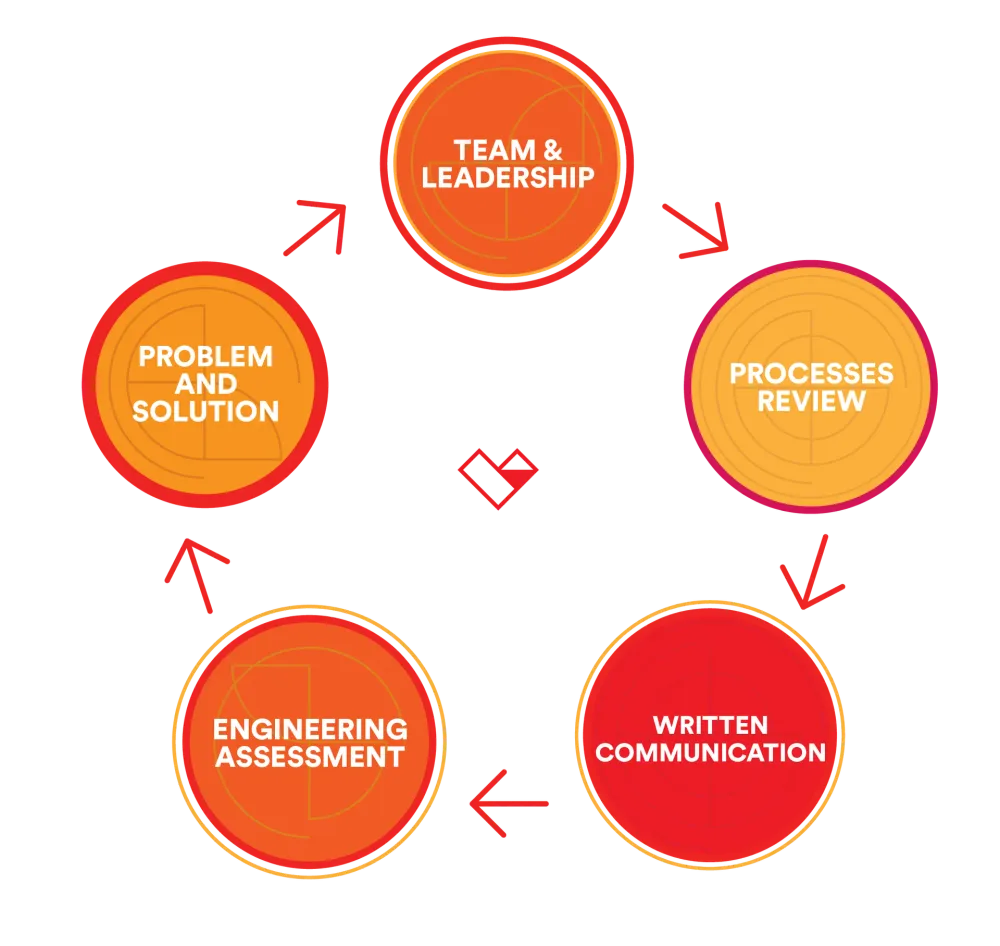Technical due diligence (TDD) is a critical process that provides investors and companies with a comprehensive assessment of a startup's technological foundation. We like to say a technical audit technically de-risks your next funding round because the goal of due diligence is simple: figure out the hidden secrets of the target company that may hurt its value or even kill the deal. It ensures transparency in technological capabilities, revealing a company's tech stack's strengths and weaknesses.
This guide will delve deeper into TDD, exploring its stages, significance, and best practices to help startups and investors find their way through this process successfully. It’s extremely helpful to determine potential issues and challenges your startup has if you are a non-technical founder.
Understanding technical due diligence
Technical due diligence is a thorough evaluation of a company's technical infrastructure, architecture, and technology strategies. This audit examines the entire technical ecosystem, from the tech stack's architecture to the company's compliance with data privacy standards. The goal is to help investors and companies fully understand the risks and opportunities associated with the startup's technology.
Seed-stage and Series A
In our experience evaluating venture capital investments in seed-stage and Series A rounds, the focus is on assessing companies seeking to extend their runway by 12 to 18 months. In the startup world, "runway" refers to the amount of time a company can operate before its cash reserves are depleted. If the company runs out of runway without taking off, it's at risk of a crash.
Seed-stage investments typically provide up to $2 million to help companies discover their market fit. If they successfully establish a user base or a steady revenue stream, the company may pursue a Series A round to fund growth and scale-up operations. At this point, the pressure intensifies as the company races to meet revenue and growth targets before funding runs out.
Securing a larger investment triggers a crucial inflection point. Teams must shift from a startup mentality, characterized by rapid iterations and cutting corners, to a scale-up mindset that prioritizes quality and sustainable processes. This cultural shift is challenging and necessitates a clear understanding of the technology stack and technical debt accumulated along the way.
Tech DD plays a pivotal role in this process by offering the technical expertise needed to navigate this transformation.
The importance of Tech DD
Technical due diligence serves several key purposes:
- Value Assessment: TDD reveals the true value of a startup's technology.
- Risk Evaluation: It identifies potential risks that could impact the investment's success.
- Technology Roadmap: TDD provides insights into the technology roadmap and how well it aligns with business goals.
When is technical due diligence required?
TDD is often triggered by significant corporate events such as:
- Mergers & Acquisitions (M&A): To evaluate technological compatibility and future scalability.
- Initial Public Offerings (IPO): To ensure the company’s tech can handle public scrutiny.
- Investment Rounds: Especially during seed funding, where tech viability is critical.
Who conducts technical due diligence?
Investors typically initiate TDD, often engaging third-party experts or in-house technical teams. This is where we come in. With our audit service, we help investors screen startups and scale-ups they are interested in. With our background as software engineers and in-house CTOs, we always have experts available to conduct an audit quickly. We strive to finish the process within 2 weeks, conducting up to 8 interviews and a deep code review.
However, startups may also self-initiate a tech audit before seeking funds to identify weaknesses and prepare for investor scrutiny.

Take a look at our audit sample report
With our technical due diligence service, our senior engineers and experienced CTOs will technically de-risk your next funding round. In only 2 weeks.
The technical due diligence process
A comprehensive technical due diligence process generally consists of these key stages:
1. Preparation & gathering all information
The first requirement for proper due diligence is to gather general information about the target company. This includes the company name, address, tax registration number, URLs, ownership structure, and publicity and marketing materials.
Why this matters: Investors want to verify the company's basic information and ensure it’s legally registered. Is it a real business? Who is the investor planning to bet on?
Preparation is crucial for a smooth TDD process. Start by securing essential documents like NDAs and letters of intent. Compile all technical documentation, including architecture designs, API documents, and performance metrics. This foundational step ensures transparency and sets the stage for a thorough evaluation.
2. Baseline interview
We start with a baseline interview, which is a two-hour call with the CTO (or other senior leadership).This strategic meeting covers a lot of ground. The goal is to learn about the key players and stakeholders and the main areas to focus on during our remaining interviews.
We prepare for this interview by getting access to an org chart and deciding on 3 to 5 key questions (from you or an investment team). We also schedule placeholder interviews.
This strategic meeting aligns expectations between the parties. The agenda, timelines, and areas of focus for the TDD process are established. This initial alignment ensures that the TDD process is both thorough and efficient.
3. Codebase deep dive
We go through your codebase and will try to understand the general state of it. Behind the scenes our team dives deep, checking for best practices across the various systems. During interviews, we zoom in on specific details in an effort to understand how a team thinks about their work.
Documentation plays a significant role in the TDD process. It should provide insights into the product's architecture, infrastructure, and technical design. A thorough audit also assesses the thoroughness of backup and recovery plans, integrations, and process frameworks. An organized documentation review reveals the startup’s attention to detail and facilitates a smooth TDD.
4. Interviews
During live meetings (they can be remote) between technical experts and the startup's most important team members, we ask questions to fill in all remaining gaps for the report.
These calls give a deeper understanding of the product’s architecture, roadmap, and critical features. This step involves analyzing the architecture, UX/UI design, scalability, and security. But we also gain a lot of information from the newest employee on the onboarding process and company culture, or from the sales department about the roadmap, feature releases, and the existing client base.
6. Reporting
The final stage involves compiling a detailed report summarizing all findings, identifying risks, and recommending improvements. We make sure to anonymize our findings to make sure all people we speak to are not hindered in telling the truth.
We generate an executive summary and answer the key questions to generate direct value for founders and investors. The report serves as a critical tool in shaping future technical strategy and investment decisions.

Critical pillars of technical due diligence
1. Infrastructure
A startup's infrastructure comprises hardware, software, and networking components. The assessment includes scalability, availability, security, and overall system architecture. Understanding the infrastructure's robustness helps gauge the company’s capacity to handle growth.
2. Code quality
Assessing the code's integrity, cleanliness, and modularity is crucial. Evaluating coding standards, architecture, and technical debt gives investors a clear picture of the technical foundation. Key factors include code style, modularity, and adherence to best practices.
3. Scalability
The scalability of the architecture determines how well the technology can handle growth. This includes the evaluation of databases, cloud infrastructure, and disaster recovery plans.
4. Team and workflow
The technical team’s expertise and workflow efficiency are critical to the startup's success. Assessing team composition, development processes, and adherence to best practices ensures the tech is in capable hands.
5. Security and compliance
Data privacy, security protocols, and regulatory compliance are essential aspects of TDD. Understanding how the company protects its assets and meets regulatory requirements is crucial.
6. Product roadmap
The technology roadmap provides a clear view of the company's future plans. Assess how well the roadmap aligns with the business strategy and potential for growth.
7. Technical debt and legacy systems
Identify legacy systems and quantify technical debt. Outdated technology can slow development and present integration challenges, impacting scalability and security. We specialize in working with legacy systems and with technical debt.
8. Continuous integration & deployment
A robust continuous integration and continuous deployment (CI/CD) pipeline can be used to automate the rigmarole of releasing new versions. Your engineers should focus on removing roadblocks that prevent them from delivering value to end-users each and every day. The CI/CD pipeline is the main way to address these obstacles, complete with automated tests and other quality checks.
Best practices for technical due diligence
Review these tips and practices to ensure your company starts in the front row before the audit takes place. They often lead to successful stories.
1. Document everything
Thorough documentation is key to a smooth TDD process. Detailed and accurate documentation demonstrates transparency and ensures clarity during assessment.
Reading tip: 5 documents every startup should have
2. Automate testing
Automated testing identifies code issues early and improves code quality. This proactive approach minimizes technical debt and ensures a reliable product.
Reading tip: Refactoring towards testability
3. Prepare for Growth
Plan your technology stack and architecture for scalability. Ensure that infrastructure and systems can handle increased traffic and usage.
Reading tip: Decoding startup success
4. Maintain security standards
Regularly review security measures and data protection policies. Staying ahead of potential vulnerabilities ensures the safety of your product and data.
Reading tip: The Ultimate Due Diligence Checklist
6. Create a proper roadmap
Think about how to gain trust when presenting your roadmap to investors. How to manage expectations? What do investors and Venture Capitals care about when they ask for your roadmap?
Reading tip: Communicating a roadmap to investors and VCs
7. Team composition
It’s probably an open door, but having senior engineers from the start will greatly help your startup's success. It’s a good idea to start hiring junior talent only as soon as your product has proven its value.
Reading tip: Never hire senior developers*
8. Involving the whole organization
Technical due diligence should not be siloed. Engage with product management, legal, and marketing teams to ensure comprehensive insights. A cross-functional approach ensures all potential risks are identified and mitigated.
Reading tip: How we tackle due diligence
9. Evaluating tech leadership
Evaluate the CTO’s vision, leadership, and ability to execute the technical roadmap. Strong leadership can drive innovation and build a cohesive technical team. A lot of the problems we see when conducting audits are in fact people problems.
Reading tip: CTO coaching and mentoring

Other interesting reads on audits & due diligence
- A story on remote audits
- Why tech startups fail
- Most common challenges faced by startups
- The Ultimate Startup Due Diligence Checklist
- Due diligence in the age of social distancing
- How we do due diligence & audits
Conclusion
Technical due diligence is an extremely important step for startups seeking funding, acquisitions, or growth opportunities. Technology audits uncover a company's technical strengths and weaknesses, allowing for a thorough assessment of risks and opportunities. By following a structured TDD process and adhering to best practices, startups can ensure transparency, mitigate risks, and align their technology with their business strategy.









Member discussion